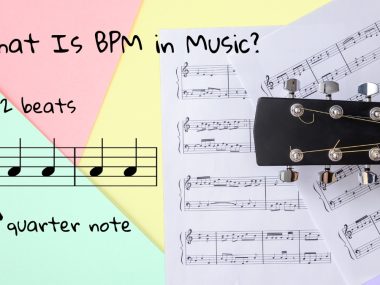I’m a huge fan of rock music, and one of my favorite things about it is how a song will start slow or mellow then gradually rise to a satisfying climax. In the world of music, there’s a specific word for this occurrence, and it’s crescendo.
But, what is a crescendo in music, and how do musicians notate crescendos in sheet music?
In this article, we’ll discuss everything regarding crescendos in more detail. Whether you’re a student, a beginner musician, or someone with some musical background, knowing all about crescendos is essential.
Let’s dive in headfirst!
What Is a Crescendo in Music?
Crescendo is an Italian word, derived from crescere, which translates to “to grow.” In music, crescendo refers to the gradual increase in the volume of music throughout a piece or a song.
Crescendos as a concept aren’t just limited to classical music. Rather, they’re well known amongst professional musicians everywhere and they’re present in all musical genres. They’re available in the musical notation of jazz, rock, country music, and more.
Not only is the act of crescendoing pretty popular in all musical styles, but also its specific dynamic markings.
Now, with this in mind, have you ever wondered what crescendos look like in sheet music?
How Do Composers Notate a Crescendo in Sheet Music?
When indicating that there’s a crescendo in sheet music, a composer has two ways to do this. The first method is quite loose compared to the second one, but it gives more freedom to the conductor or the musician. The second method is more precise.
Let’s get to know each notation form more in-depth.
The First Method of Notating a Crescendo

In this case, a music composer will simply write the word crescendo on the musical score. The word is often abbreviated to cresc. and usually appears at the point where the music starts to rise in volume.
Plus, the composer will indicate the exact point where the music reaches its climax by writing the dynamic marking that the crescendo is rising up to. For example, the composer will write forte (f) or mezzo-forte (mf) to indicate the climactic point.
Still, in some instances, musical scores won’t contain such dynamic markings. This leaves more room for conductors or players to interpret the crescendo as they see fit.
The Second Method of Notating a Crescendo
Quite the opposite, this form of writing a crescendo follows some precise rules. It includes markings that look a lot like hairpins or inequality symbols. However, most musicians refer to those markings as “hairpins.”
A hairpin crescendo symbol indicates the crescendo’s exact length within the musical piece. It also shows the prescribed volume at the beginning and the end of the crescendo.
Imagine two intersecting lines on the symbol’s left end and the lines slightly open outward to the right. This sign refers to the beginning of the crescendo.
It’s also worth noting that the symbol’s mirror image indicates a decrescendo. A decrescendo or diminuendo is the opposite of a crescendo. It means a gradual decrease in volume in a musical composition.
Oftentimes, these hairpins will be accompanied by dynamic markings to further ensure the accuracy of how the crescendo will sound.
What Are the Dynamic Markings That Can Bracket a Crescendo?

Dynamic markings refer to how soft or loud a note is during a musical piece. When these bracket a crescendo, they can help the player reach the desired increase in volume that the composer has in mind.
Here’s a list of all dynamic markings that can appear with a crescendo.
- ppp: This marking means “very, very soft” and it’s an abbreviation of pianississimo
- pp: This marking means “very soft” and it’s an abbreviation of pianissimo
- p: This marking means “soft” and it’s an abbreviation of piano
- mp: This marking means “somewhat soft” and it’s an abbreviation of mezzo-piano
- mf: This marking means “somewhat loud” and it’s an abbreviation of mezzo-forte
- f: This marking means “loud” and it’s an abbreviation of forte
- ff: This marking means “very loud” and it’s an abbreviation of fortissimo
- fff: This marking means “very, very loud” and it’s an abbreviation of fortississimo
In a crescendo, the quieter dynamic marking will appear to the left side of the hairpin symbol, and the louder marking will stand to its right side.
In a decrescendo, the opposite will happen. The louder marking appears to the left and the softer marking is written on the right.
How to Recognize the Duration of a Crescendo?
It’s always easy to know the duration of a crescendo in a musical score. Simply, it’s the entire distance between the initial indication marking and a new dynamic mark that’s louder than the crescendo’s starting dynamic.
However, the length of a crescendo may not be that straightforward to indicate in a longer musical passage. In this case, composers will write a dashed line that begins at the word cresc. and keeps going until the end of the crescendo.
Still, in most cases where a hairpin symbol is used, the crescendo will only stretch as far as the hairpin goes. This is valid whether or not a new dynamic marking appears.
Now that you know a few basics about what a crescendo is, how it looks like, and how to know its length, let’s briefly explore its origin.
The Origin of Crescendos

The concept of a crescendo has been around since the beginning of time. Ever since humans discovered music, the act of gradually increasing in volume has come naturally to musicians in all cultures and backgrounds.
Yet, the specific indication of a crescendo in music notation hasn’t been recognized until the 17th century. At that point, more and more composers began to represent their crescendos more accurately using dynamic markings and other specific directions.
Finally, the hairpin symbol has been standardized as the beginning of a crescendo in the 18th century. Impressively, musicians and composers have been using it until this day.
How Are Crescendos Different From Accents?
Some people may be wondering how crescendos and accents compare. The first thing you should know is that both have effects on the sound and volume of the musical piece. They also refer to an increase in loudness.
Other than that, these techniques differ to a great degree.
Accents, unlike crescendos, happen when a composer wishes a certain note to be louder than all the rest of the notes. This shift in volume is sudden, while it has to be gradual in a crescendo.
There are also other ways to create an accent rather than an increase in volume. The composer may like for a note to sound stronger by making it longer or shorter than the other notes.
How to Play a Crescendo?
Incorporating a crescendo into your music can give it a welcome richness. See, playing all the right notes, having incredible timing, and other music-related skills are appreciated. Yet, mastering crescendos is simply the cherry on top.
Of course, playing a crescendo correctly requires some practice, which, quite frankly, is all you need to master any skill in the world of music. The most important thing to know before playing a crescendo is that the shift in volume needs to be gradual.
Don’t let the dynamic shift happen all of a sudden. Instead, you should go little by little, which is a piece of advice that many composers include in their musical scores to stress this idea. Oftentimes, they’ll simply write the Italian phrase poco a poco.
However, if a composer requires a sudden increase in volume, there’s an easy way to tell. He or she will include dynamic markings for that purpose, such as sforzando, sforzato, forzando, and forzato.
Therefore, if you stumble upon the word crescendo or see a hairpin sign on the musical score, prepare to extend the change in dynamics over the length of its duration. Of course, with patience, practice, and determination, this should come more naturally to you.
Crescendo Practice Examples for the Piano

Because practice makes perfect, here are a few ways you can begin your crescendo-learning journey. You can try the following techniques when you practice your scales, arpeggios, warm-ups, and the like.
For instance, you could play G triads with a change in volume level starting soft and then louder on the way up. Then, go from loud to soft on the way down.
Another cool exercise is to play a warm-up session moving from very soft, to medium-soft then back each time you repeat it. This practice will allow you to notice subtle changes in volume with each repetition.
You can challenge yourself to stay in control so that every shift will sound exactly the same every time around. As you know, full control of your instrument’s dynamic range is essential to hit a perfect crescendo each time.
Lastly, you could try playing a C major scale in both hands with one hand playing a crescendo while the other doing a decrescendo. It may be a bit tricky, but once you do it successfully, it’ll sound magnificent!







